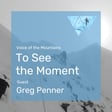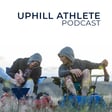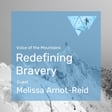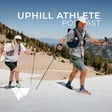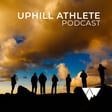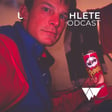Introduction to the Podcast and Guest
00:00:11
Speaker
Welcome to the uphill athlete podcast. We're here to inspire and educate athletes. And today I'm psyched to bring on Drew Hammond, who has been on the podcast before. um But those of you who have tuned in, yeah, you have been. I was looking back through the episodes. But those who are kind of, let's say within the last, honestly, year or two, it's been a little bit.
00:00:37
Speaker
um Last year or two, we have drew back on and unknown i'm an and pretty known long time listener. Second time caller. Happy to be here. Happy to have you drew. I'll give a little, little highlights of drew and then ask him about himself.
Guest Background and Expertise
00:00:56
Speaker
But drew has a lot of experience in special operations and military. He's big into hybrid training, which is definitely a term that has
00:01:08
Speaker
had sparkles around it for a while now. um He is has an MSC in strength and conditioning, also tactical strength and conditioning facilitator, certified strength and conditioning specialist, CrossFit Level 2, which we won't hold against you. and he I think it's expired. In fairness, I think it's expired. yeah All right. Yeah. He loves to test limits and inspire unconventional athletic journeys. He's the co-host of mops and mows, which highly recommend you check out. And he coached my husband through dive school during COVID when my husband was literally laying on a bench using rubber bands to pretend to swim. So we all had fun with that.
00:01:56
Speaker
We were making it up as we went along, but it worked. He passed. What are you guys doing that time? We were all making it up. It was great times. What was the word that you used? Unconventional training. Exactly. Perfect.
Career Path and Military Experience
00:02:10
Speaker
Nailed it. Yeah. Well, thanks, Drew. Thanks for being on. Of course. so How did you get into... Well, first off, I want to say this podcast is going to be looking at strength.
00:02:24
Speaker
which is something all of us endurance weenies aren't the best at. Yeah, happy to have you here. How did you get into the tactical side of things? Drew is also our our tactical coach at uphill. And yeah, a little bit about that journey. ah It was I mean, I'll use the same word again. It was unconventional.
00:02:49
Speaker
um I went to school for business, actually, business degree. Oh, I didn't know that. Okay. Well, here's a better one. My minor is in African studies, which I've used zero times, but for folks that... So I went to Chapel Hill. So for anybody who's familiar with UNC and UNC sports and sort of the controversy around the African studies program, I was involved in all of that unknowingly. I won't go into it. You guys can Google it, but it was a great time.
00:03:16
Speaker
anyway While in school, i had I had strongly considered joining the Marine Corps, which is my exposure to the military setting. um But interestingly, the guy in charge of this region for recruiting got kicked out. So my ah my plans were derailed somewhat, and I instead ended up in graduate school in Scotland doing strength and conditioning.
Educational Background and Early Career
00:03:38
Speaker
Did a little bit of work with the British military over there. They had a rehabilitation unit in Edinburgh that I worked with um and did not know at the time
00:03:48
Speaker
this was like mid 2000s, I guess, that the military, the US military and specifically special operations was just getting started with embedded human performance. um So I The best I can recall is that I had my resume online somewhere. And one of the companies that was awarded the contract to employ strength coaches for Air Force Special Operations found me and thought that I was suitable. I think they had the wrong person, but um they hired me. And so I left grad school and went right into strength and conditioning for Air Force Special Operations. So that was me as the coach effectively
00:04:28
Speaker
dual hatting as somewhat of an injury prevention guy and also somewhat of a nutrition guy and also somewhat of a like mental health guy, but primarily a training guy. Uh, we hadn't built the rest of the team yet and I had a hundred and ish, 150 ish, uh, door kickers that were looking to me for coaching. So that was the start of like doing the thing right out of grad school. And then.
00:04:54
Speaker
for folks that I guess are somewhat familiar with the way that the military works, the special operations side of human performance was getting built out, still is getting built out, but I kind of rode that wave and then moved back home to the East Coast.
Transition to East Coast and Army Work
00:05:08
Speaker
That was out in Arizona, moved back home to the East Coast to do somewhat of the same thing, but now with the conventional army. So whereas before I was on the floor, coaching, programming. Now I'm in more of like, I say that I've gone corporate now in that I i manage a team that provides that service for 2000 soldiers. So still very physical training heavy, but um balancing a lot more of the other disciplines. And then while that's all been going on,
00:05:38
Speaker
doing remote coaching and remote healthcare care type stuff. I think the nature of this industry is such that you sort of have to have side hustles. That's the background. Like I said, the CrossFit cert has expired, I think. Most of the most of those certs probably have expired. but I think I still know some of it. I think so. And I think truly by virtue of me just not being good at endurance, I've become kind of that's the quote unquote strength guy for uphill. I don't know if it's called the smartest person in the room, lest that I just am the worst runner. Um, so yeah, that's my background. Love it. I actually did not realize you had never actually been in the military.
00:06:21
Speaker
I think I kind of knew that, but yeah. and well and What's interesting is that, and again, not to get in the weeds with contracting versus civilians versus active duty or whatever, but most people in this space are either former military or From the other side, a lot of the coaches in this space are former professional sport. And I was neither. I was never active duty, but but I was also never a coach in sport. I had always been a coach in the tactical setting. So I think I'm a little bit of a rare breed in that sense for better for worse. But yeah, I was a contractor. And then since then I've been a civilian working for the military. Nice. You're special, Drew. We can say that. Thanks. I appreciate you. Yeah. My mom used to tell me that growing up and so I'm glad it's carried on.
00:07:08
Speaker
Yeah, mine too. but
00:07:12
Speaker
So now that's super yeah. It's it is super interesting. It is kind of funny how the side hustle thing seems to always be present, but yeah. Getting into the coming at things from a strength background verse more of the endurance background and do you coach You primarily coach tactical athletes. um Yeah. ah Do you have kind of like, say, because we will will have I mean, just to be, I think, say the obvious, there's less probably tactical people listening to this episode, then there are people who are mountaineers runners, alpinists, ice climbers, skiers and all of that. How do you think about and this is what we want to focus in on today? and
00:08:05
Speaker
coming from coming at an endurance sport perspective that is requires a lot of strength from a strength first versus we always tend to I think put strength second. Like how do you think about that?
Balancing Endurance and Strength in Training
00:08:21
Speaker
Um, I mean, I don't know if I would, I wouldn't go wholesale strength first as much as I would say strength not second, if that's fair. to say Only because the reason I say that is
00:08:35
Speaker
I don't think a lot of folks that are outside of the tactical setting realize the sheer amount of endurance that is required to perform well, especially for some of the peak events like selection events into special operation units and that sort of thing. And what's interesting is that As the embedded human performance concept has grown over the last couple of years in the military setting, there's almost been a shift away from thinking as tactical athletes as strength power athletes and starting to shift towards tactical athletes as endurance athletes who have to be strong. um Which is why I say it's, I wouldn't come at a, like if somebody comes to me and says, hey, I want to assess for
00:09:24
Speaker
XYZ unit in six months or a year, whatever. It's not like, okay, let's jack up your deadlift and your bench press and you know, all these sorts of things, but also maybe go for a couple of runs. It's more how far can we push your endurance while maintaining and in some cases building your strength? Because bear in mind, yes, you might have to do a 40 mile rock. That's said a graded event. That's like some ultra endurance stuff.
00:09:54
Speaker
Before that, there's also a PT test where you have to deadlift 350 pounds or whatever um just by nature of the way that the military sets up their PT test. so You end up with this really interesting problem set that you have to solve for, which is that how do you how do you do the least amount of work to get as strong as you need to while also doing the least amount of work required to go as long as you have to for these different things? because I think a lot of folks think about what's required to engage in combat, but before you get to combat, you have to get selected for some of these units. And in order to get selected, you have to be able to do some pretty heinous and long duration stuff. So sure you have to run a marathon, but when you get to the end of the marathon, deadlift 500 pounds. That's basically what we're trying to figure out how to do. No. And I think to tie that into,
00:10:53
Speaker
say someone who is a mountaineer because to be honest, like I know that it's it's like we're using the term tactical, but that's not that different from climbing right here where you have to carry a 50 pound pack. Yeah. very That's the thing. like They're very, very similar. um And I think what I would say is you you often hear Oh, you you know, no matter who you are, you have to like, it helps to have an aerobic base. The bigger aerobic base you have, like the better off you are, no matter what it is you're trying to do. And I agree with that. I would also posit that no matter who you are, the stronger you are, the better you will be at whatever it is you're doing climbing or near doing an ultra. If you're weaker, you're more likely to get injured, less likely to complete the entirety of your tat, whatever it might be. So.
00:11:42
Speaker
I think there's an argument to be made that you should excel, like quote unquote, at both of those things. It's just a question of balance and and what does excel actually mean in your you're given context. um So yeah, I know we're we're circling so many rabbit holes, but like, that's kind of what that's kind of what you we try to figure out.
00:12:00
Speaker
Yeah. Well, I mean, I think that's the part that as coaches keeps you coming back. It's like, yeah how do you figure this out? well And that's, that's the thing too. And you mentioned hybrid as like a buzzword and ah it is, I think certainly in the last couple of years on social media, it's taken off and it's become like the new sexy. Um, which is actually super interesting because you are starting to see things happen that are defying sort of traditional at least strengthen conditioning knowledge, but arguably endurance knowledge too. And what I mean by that is there's plenty of people on Instagram now who are stacking like the 500 pound dead low sub five minute mile, 500 pound squat sub five. I mean, there's some crazy things that are happening.
00:12:46
Speaker
um And I think that we're, so we're starting to hopefully move away from this misconception that getting stronger is going to make me a bad runner or getting better at running is going to make me weaker. Like I think that we think about it in extremes and like, certainly if you want to go for a sub two hour marathon, strength might deplete some of that. But if you just want to finish the marathon or maybe like finishing the top 10% or whatever, like you can be stronger than you think you can be.
00:13:18
Speaker
On the other side, it's like you're not going to, so if if you're trying to win a gold medal and the snatch
Hybrid Athlete Performance Feats
00:13:23
Speaker
or the clean and jerk, like, yeah, you probably don't need to run a marathon, but you could be stronger than most people and still be able to sign up for a 5k on a whim. Um, hopefully we're getting more towards that as normal, but I i don't know, i maybe not. Yeah. Well, it's funny cause I kind of joke about the hybrid athlete with a few friends and we always say,
00:13:46
Speaker
you know, it's just like, oh, yeah, so you're just someone who's strong and can run, like, a lot of people should be, you know, it's kind of like, Oh, yeah, shouldn't we all be hybrid athletes? I mean, yeah obviously, there's, um you know, periodization, etc. But I'd hope that most people could be pretty strong and run, yeah okay, or, you know, whatever endurance, like, they're not,
00:14:14
Speaker
mutually exclusive, they kind of pull if there's some give and take in it, but probably can be stronger and run further than you think. Yeah. Yeah. And it's funny because I think if you look back at, and I love this sort of stuff like old school physical culture and and like the old school, I mean, most of it is like, you know, bodybuilding on the beach or whatever, but you look at a lot of what those folks are doing.
00:14:39
Speaker
And it is the type of training that we would now think of as quote unquote hybrid because you know, we have to label everything, but certainly from the eighties, 90, like we, we did go through a period of thinking that you had to specialize absolutely in a particular discipline and anything, anything that was anything that didn't look like that discipline was assumed to then detract from the end goal. And I think in some cases that can be true, but for the general population, there's nothing that says you shouldn't be able to,
00:15:09
Speaker
Sit down and stand up with some weight on your back. Also run down the road without being out of breath. Also touch your toes. Like just, you know, simple stuff that I think a lot of people leave behind in pursuit of some perceived singular goal. Um, but I'm sort of proselytizing at this point. I mean, it's, it's a good, it's a good hill to die on. Yeah. Yeah. It's also, I mean, I think too, again, unless you're at a very,
00:15:40
Speaker
specific point in your life where maybe you are a pro athlete, maybe you are joking and you do need to be a little bit more specified.
00:15:53
Speaker
I also would like my athletes to be well rounded where it's like, we're not so polarized that they can't do a pull up that yeah, they can't touch their toes. It's like, okay, then we've gotten way too far in the endurance direction. Right. Because that's like, that's a human, like you should be able to pick up this box. And well it goes book it goes both ways, right? I mean, like, yes, for the endurance athlete,
00:16:18
Speaker
having some strength is important. I mean, you could get into the weeds with like bone mineral density and all that sort of stuff. I mean, even just from a longevity standpoint, but conversely, and we'll probably do this a bunch while we're talking, like the same holds true for the other side. Like there are guys that I know who can squat a house and deadlift a car, but they can't sleep without a CPAP because they'll like die. So, you know, cool. You're super strong. That's awesome. I would prefer it if you could,
00:16:48
Speaker
you know, go get the mail at the end of your driveway without being out of breath. So I think both both ends of the spectrum, both camps would probably do well to look over the fence at what the other side is doing. And that's that's really where kind of the capital H hybrid athlete falls, but interestingly also where the tactical athlete sits, because I guess in my opinion, you have to be able to do both of those things. Yeah, to be honest, I mean,
00:17:17
Speaker
When, before you were on board, I, I've coached a couple of tactical peeps to do some selections and it was really fun because it was like, Oh, you're not terrified of strength training. Excellent. And you're also like kind of excited to do more of the endurance stuff because traditionally that's probably something you've done a little bit less and they follow direction really well. Yeah, that's the best part.
00:17:45
Speaker
yeah But it was very fun to have people who were so psyched on strength training because with a lot of other athletes I have, it's like pulling teeth or it's like, wow, you nailed all your runs, but you you forgot all the strength. Yeah. Whoops. I forgot my strength. Sorry. I was out running. Yeah. So I want to give to, we'll call him prototypes of people.
00:18:14
Speaker
uh let's say they're both we'll start with one climbing right near 120 ish pound woman has to carry 45 pounds minimum up right near we're talking end of June climb date coming in not a lot of strength background isn't doesn't love strength worried about bulking up How are you programming her strength in the neck, in the next little bit? What are you thinking for preseason? And then yeah, walking through kind of like a little outline. He has not been primed on this. So this is this fine. who have We totally practiced. Um, I mean, preseason, as with anything, you have a lot of room to work on weaknesses and, and kind of, I mean, some of the phrasing I use is.
00:19:09
Speaker
you know, push the ceiling versus raise the floor. And so in preseason, I'm all about raising the floor, like addressing all the basic variables. And and in this case for this particular athlete, it sounds like the big gap is going to be strength and particularly absolute strength. And I may make some enemies by saying this, but for endurance folks, a good way to think about absolute strength is the same way you would think about your aerobic base. Like ah a broader aerobic base will allow for more intensity work later on. Similarly, a broad base of strength will allow for more muscle endurance type work later on because you're you're pulling from a much bigger capacity to move mass, which is effectively what but strength is. And so for her in this case, yes, obviously we're going to include the rucking and getting under load and and building up hip strength and midsection strength and core strength and all the things that you would do for a loaded movement
00:20:04
Speaker
uphill. um But I think where my stuff might look a little bit different from others is that we would also be including some basic strength moves. um Things like back squats, things like deadlifts. If somebody is not partial to a back squat, they don't like having a bar on their back, that's fine. We could put dumbbells in their hands and do the same thing where we could do split squats. I mean, there's there's all kinds of different ways you can go at the movement patterns.
00:20:30
Speaker
which is how I think about strength, less movements and more movement patterns. Um, so I guess, you know, upon first contact with said individual, it would really be figuring out where are there aversions to strength training? What, what about strength training sort of scares you, I guess I would say. Cause I do this with my tactical guys too. I mean, sometimes there was an aversion to deadlifting because they think they might hurt their back or,
00:20:57
Speaker
Sometimes they actually do have a hurt back. And so spinal compression through axial loading, like with a back squat is off the table. So we might look to switch something up. So during the preseason, specifically for strength, I would probably be implementing a big variety of different movements to figure out what she falls in love
Preseason Strength Training Approach
00:21:18
Speaker
with. Like what does she like? Assuming this is somebody who hasn't done a lot of strength training, hasn't been exposed to a lot of these movements.
00:21:25
Speaker
we can use movement variety to break down a lot of preconceptions about this type of strength work while also simultaneously showing her that her endurance is not necessarily suffering. Like we can balance our stressors throughout the week, and that's getting a little bit into the weeds, but we can balance it in such a way that she can still do the endurance work that she knows and loves, but also hit some strength stuff that she may not have been previously exposed to. She might find that her runs actually improve because she feels a little bit more robust, um, when she throws the weight on her back and does start doing some of that more sports specific stuff, as we get closer to the event, it might feel a little bit lighter. She might move a little bit better because she's stronger. Not to mention our likelihood of injury goes down because again, she's a little bit more bulletproof. Um, so that's how I would, I mean, that's sort of a vague answer, but like, that's how I would come at it from a preseason standpoint, playing around with rep ranges.
00:22:21
Speaker
playing around with movements, figuring out what she likes so that when the time comes and we do have to whittle away a lot of that extra volume, we can hone in on the things that we saw that were successful during preseason and really get the most return on investment. I love that. What would you say, and I'm going to follow up with something else, but first thing, in terms of volume, are we talking three times a week, four times a week? like What does that look like?
00:22:48
Speaker
you'd think I think my like my immediate reaction to that question is it's typically less than people think. um and um like For me, i would probably and I say would because this is what I actually do. like I think three days a week is a good starting point in like a preseason situation.
00:23:08
Speaker
Because again, if this is somebody who hasn't been exposed to much strength training, one of one of the thoughts in the front of my brain is we need to build habits and we need to build exposure. And if we only do that once a week, we're not really getting into the habit of of maybe it is going to a gym or or at least getting under load. Now, how long each one of those sessions are depends. I mean, it could be short, but it's okay. We're still getting into the habit of doing strength work.
00:23:36
Speaker
And because we're talking, like I was saying previously about introducing more variety and different things like that, it just it gives me more opportunities to plug frequency across the week. um So assuming it's three days a week, maybe it's two. you know Sometimes i'll I'll create sort of two primary sessions and then ah a third session that's kind of a floater. So, hey, at the very least do these two. If you get to this third one, great. If you don't, not a big deal.
00:24:05
Speaker
Um, and that gets into some of the auto regulation stuff. I know that we'll talk about, but getting even further into it, like rep ranges and things like that, typically anywhere from like, I don't know, eight to 15 ish would be ah a starting point. Any, any more than that, like 15 and beyond, you're, you're sort of not going after strength. You're going after more strength endurance.
00:24:30
Speaker
Anything below that, um and I think, sure, it's going after more absolute strength, but also I think it scares people who are not used to doing strength. yeah um So I think the eight to 10 to 12-ish to 15-ish range is is good because for somebody who's not used to taking weights to the level of fatigue that they need to to create a stimulus, you can at least hope to get close to that in that rep range. Whereas if I were to say, Hey, you know, go to three reps, they might take a super lightweight and do it three times and think that they accomplished the goal. And realistically, that's not what we're after on that end of the spectrum. Vice versa. If we're going after 25, 30 reps, who's to say what the right intensity is for that? I mean, you're just winging it at that point, but yeah probably a longer answer than you wanted. But that's, that's kind of where my head goes with volume. No, this is great. I mean, I think it's, to be honest, I think there's,
00:25:30
Speaker
So much room for growth in this area, to say the least. Yeah, pun intended. No pun intended. And you keep popping up other questions, and I can't even get back to my ah point that I wanted to make. But one last question, and then I will get back to it. How are you layering this with, say, a higher intensity workout in there and a longer effort? How is that stacking for you?
00:25:58
Speaker
So what what I do, and and this is just me, I mean, this is kind of hot kind of how I was taught and learned for for the hybrid setting, in which other folks might call it concurrent training or whatever. Hybrid hybrid hybrid. Yeah, hybrid hybrid hybrid. The term I use is called consolidation of stressors. I didn't make that term up, but the logic is that your body doesn't really know the difference between sprinting, squatting. like It all comes down to tension and energetics, which that's really as deep as you need to go. and and All that really tells you is that if I think about training from a bioenergetics and a muscular tension standpoint, I can now start to tease out the more muscle endurance type work and pair that with more of my low intensity, high volume endurance work. and Similarly, I compare my higher intensity, low volume endurance work with my higher intensity, low volume strength work. and so
00:26:52
Speaker
across the week, and again, these are ideal scenarios. Nobody ever really has these down in an ideal way, but across the week, you end up kind of earlier in the week, hitting higher intensity, lower volume strength and endurance work. And then as you move through the week, sort of moderate intensity, moderate volume, that might be where you see your tempo runs and some of your more upper body type strength work. And then towards the end of the week, usually because people just logistically have more time for it,
00:27:20
Speaker
That's where you'll see your higher volume, lower intensity endurance work and also your higher volume, lower intensity strength work. um I'm painting that with a very broad brush, but effectively what that ends up creating for your standard athlete is a situation where Early on in the week, we experience a lot of intensity. We don't experience a lot of volume. Maybe that's where we consolidate soreness with the lower body so that by the time we get to Wednesday, Thursday, Friday, the lower body has more or less recovered. So we're prepared for a weekend of like long endurance work. I think that where people go wrong when they try to do strength and do endurance is they take a strength program and they take an endurance program and they put them together.
00:28:02
Speaker
And that might work for a couple of weeks, but what ends up happening is that if you're doing like legs on Monday and then sprinting on Thursday, it's like your legs are sore Monday, Tuesday, Wednesday. And then you sprint, your legs are sore Thursday, Friday, Saturday. And that just never really balances out. So if you kind of stick to that consolidation of stressors idea and the higher intensity and then the higher volume and lay that out.
00:28:29
Speaker
and organize your training that way, you create a lot of opportunity for pursuing both things at the same time. I don't know if that answered the question or not. but No, that's fantastic.
Organizing Training Stressors and Intensity
00:28:40
Speaker
Yeah, no, its it that it is ah does because this is something... Yeah, I always talk to athletes about where I'm like, we're not going to absolutely crush you on a Thursday or Friday because your your long effort is going to suck. Right.
00:28:58
Speaker
No one's having fun and that quality is really low. So it yeah, you got to balance it out more. Yeah. And I just think cognitively too, because again, the population that I tend to work with more often than not has an aversion to endurance. They don't have an aversion to strength. And what I find is that by laying the weak out that way,
00:29:18
Speaker
They get super pumped Monday, Tuesday, Wednesday ish. Cause it's like, this is the stuff I know and love and they can kind of prepare themselves for what's coming on the weekend, which is typically long rocks, long runs, whatever it's going to be for the event. Yeah. No, I think that makes total sense.
00:29:37
Speaker
So one, to go back to a point you made, and then I'll give you another profile, and then we'll talk about auto-regulation. ah I love that you said, we'll try a bunch of different exercises and see what she likes. that i If I could like highlight that underline, because I think so many people get this idea, and I say this all the time to clients, I'm like, if you are miserable doing this training,
00:30:05
Speaker
Don't do it. Don't do it. Well, yeah, there's, first off, I, people apologize to me for not liking running. I'm like, there are literally 8,000 other sports. Let's find something else for you. yeah I'll make no apologies. I don't love running. Good. Yeah. I hate swimming. Yeah. See, there you go. Yeah. I like the bike i'll bike all day long, but biking and swimming. Sure. Running. Yeah.
00:30:30
Speaker
I don't know. I'm getting better. I mean, that's a really good point. So I say that's a really good point. I realize it was my point, so now I just want you to grasp. Great point by me. That was something I came to in the tactical setting through kind of interesting logic, which was that coming from a master's degree in strength and conditioning, it's a very formalized way of learning about training. Spreadsheets like this movement does this, like it's very structured.
00:31:00
Speaker
And I was thrown into a scenario that had no structure. um So here I was thinking, oh, you would do a test week one, you'll train for 12 weeks, we'll do another test, and we'll decide if the training worked. And that's how I started to program for the the population that I was working with, the special operations world.
00:31:21
Speaker
And what quickly happened was like, hey, coach, that's great. um I'm out of town next week for training. Or I know we had this lift on Wednesday, but we did like a jump mission last night. So I'm exhausted. So periodization, capital P periodization sort of fell apart ah very quickly. um And then what I started to realize was that this myth of tactical strength and conditioning was predicated on the idea that being stronger, bigger, faster, makes you kill more bad guys. I mean, that's that's sort of the story we tell ourselves. that's That's, wow, yeah. And inevitably out of, let's say it was the 150 guys that I was working with, maybe let's say 50% of them did the training that I did. And and there were 50% that just did whatever they wanted. Some of those guys didn't really train at all. They would deploy, they would come back. And in some cases,
00:32:13
Speaker
private so-and-so who didn't really do much strength training, didn't really do much running, but killed a bunch of bad yeah bad guys and was phenomenally successful on deployment. It's like, well, if that's what we're going after, what are we really doing in the gym? like It doesn't matter if you back squat or front squat or deadlift. So I say all that to say, to the point we were talking about earlier, movements started to not matter all that much.
00:32:38
Speaker
And whereas before I felt that, oh, you want to get stronger, you need to do a back squat, a bench press, a deadlift, a chin up. Well, if a guy didn't like back squatting and would rather front squat, like, okay, that's fine. But I didn't realize that for a number of years. And what ultimately I arrived at was that the best movement for the goal you're trying to achieve is the one you're going to do. Like it doesn't matter if like the literature tells me that
00:33:07
Speaker
If the literature tells me that sorry yeah well yes the best movement, I forget exactly what I said, but the best movement for the goal you're trying to achieve is the one that you'll actually do. um Which is to say that, like yes, if you if you are training for a powerlifting meet, you need to peak for back squat bench press and deadlift.
00:33:31
Speaker
Nobody who's deploying is training for a powerlifting meet, so we don't need to peak the back squat, the bench press, and the deadlift. I absolutely understand that you can maximally load the back squat more than you can load the front squat. Sure.
00:33:44
Speaker
But if the athlete's not going to do the back squat, then even the lightest front squat is going to be heavier than the back squat that they didn't do. Same with the bench press and the shoulder press and the deadlift and the Romanian deadlift and blah, blah, blah, blah, blah. Any of the thousands of movements you can choose from and endurance. It's the same way. Like if I just want to build your aerobic base, but you hate running fine, we'll get on a bike. Like.
00:34:04
Speaker
There's not a one-to-one carryover, but that's OK. You're at least doing something that's kind of achieving the goal that we're after. And if and when we need to specialize, that's where movement selection, I think, is ah is a much bigger part of the conversation. But I'm becoming long-winded. For our architect that we're talking about with this lady who's climbing Reneer, my primary goal early on is just finding what she likes to do. And then later on, we can build off of that. I love it. Yeah, but it's honestly, no, it's so,
00:34:33
Speaker
i Cannot tell you how obvious that seems and how People like i've had more than once for athletes will just fall off the radar completely And you're like, hey, what's going on? And they're like, well, I really hate doing that. Yeah Can we talk about it? I think what it is truly and I say this from a from a strength training perspective, but I think endurance is probably similar most of the Most of the maxims in strength and conditioning that you would think come from literature come from literature that's based in powerlifting, because most of the strength
00:35:13
Speaker
literature is is powerlifting. it's It's squats and bench presses and deadlifts because it's very controlled. it's like it's It's simple. It's a single modality. so There's a misconception that powerlifting is sort of the ultimate display of of strength, which really isn't true. and Similarly, I think for folks like me who aren't necessarily endurance athletes, from the outside looking in, it seems like running is like the ultimate modality for endurance. and so If you don't like running, you're not going to do endurance. and It's like, well, we know that's not true. You can go cycling, you can go hiking, you can go for a walk, you can go for a swim, you can go skiing. Like there's all kinds of things you can do, but I don't think people really think about that because what gets shoved down their throat is run or squat bench deadlift. So here we are. Here we are. That's why we're having a podcast. So, I mean, thanks for that, but yeah, course there's a lot, there's there's so many great choices out there. You could long distance pogo stick and I would be stoked for you.
00:36:09
Speaker
I'm sure like if you Google it, somebody's done it. A hundred percent. Yeah. There's nothing new. I got a razor scooter for Christmas. I'm freaking pumped. My four year old stolen it from me, but like I'm, I'm going to steal it back because I love that thing. That's amazing. I got mine at like 11 and it was a pretty big deal. Yeah. Wheelie bar. Did you have a wheelie bar?
00:36:32
Speaker
I don't think so. I wasn't that cool. I had to wear elbow pads, wrist guards, knee pads. Yeah. My parents were like, you can get this, but. My issue was I would, I would hit the brakes going downhill and cause the, the wheels were whatever that plastic stuff is. you'd You'd create a flat spot and then you end up with like a clickety clackety scooter. Cause you anyway, yeah. Endurance. Endurance. Yeah. My husband, well, Cody was a skateboarder. And so whenever he sees, um,
00:37:01
Speaker
That checks out. Yeah. Kids on razor scooters. He's always like, I just want to knock them off of the scooter. I'm going to come. I'm going to come scooter with Cody. Cody and I are going to scooter together. it's a Great. What a bull. I mean, we're in San Diego. We're not currently right now, but normally, which is like the birthplace of all of that jazz. There's skateboard parks all over. There is. I just, I just, uh, I just googled over talking. There is a pogo stick world record distance.
00:37:29
Speaker
but most of it is just Well, most of it is just singular jumping. Here's one. Here's one for the uphill athlete community. I pogo stick to the tallest mountain in America. so when man ah denying wow this my first time ever puistic um I don't want to play it because it'll be loud and it'll take up air time, but here's one of the comments, bro, this man is so underrated. So again, there's people out there, listeners who are getting after it.
00:37:58
Speaker
I truly aspire to be an underrated pogo sticker mountain. I'm just saying it's out there. If you want to do it, it's out there. Somebody's done it. Someone's done it. Yeah. I fell into the category of running. How boring. Okay.
00:38:15
Speaker
ah okay So second scenario, And I think this will be interesting because it maybe plays a little bit into the nutrition background. We have 55 year old, we'll give him a name, Joe, investment banker, used to have a background in strength, played a sport in college, football player in college, um soaked on getting into mountaineering, wants to climb the Mountaineers route on Whitney.
00:38:48
Speaker
Um, and he is overweight though. Like, let's say 20 pounds, probably overweight. And he is pretty strong. It's not great endurance climbing and a June. What are you thinking? I think maybe somewhat controversially for him. I don't know if I would change his nutrition so much as at the start, as I would keep it stable and introduce more aerobic work and see.
00:39:17
Speaker
if the additional volume created the caloric deficit that brought the weight down. um Because he has a, but well, actually one of the first things that came to my mind is when he mentioned he played football, I'm gonna ask him about injuries. Inevitably, there are gonna be some. um I say that because I actually work with a lot of people in various capacities who fit this archetype, and that's typically where the conversation goes. um But assuming we're okay there,
00:39:46
Speaker
Assuming he has some exposure to the weight room, which you would think that he would if he played football and he's strong enough, we can kind of maintain strength. and All the things that I talked about with our previous example, Joe probably has a good idea of what movements he likes and doesn't like. so We can we can sort of shorten that exploratory phase a little bit and instead vector that more towards endurance. so If mountaineering is the ultimate goal, then yes, we're going to have to get under load on our feet, cover some miles. But if if we're more pre-seasoned, if we have some time, maybe he's on a bike doing some non-impact stuff. Maybe he's on a treadmill so it's lower impact or an elliptical if we really need to go and in the other direction. um But just building up his aerobic base the same way you would with anybody.
00:40:34
Speaker
while probably still maintaining strength, but being mindful of total volume with an eye towards that nutrition piece to see if the number on the scale is going the right direction. I think anybody listening to this podcast is going to be familiar with that feeling of losing a couple of pounds and feeling lighter on your feet. I would think that that would inevitably happen if we're looking at like a 20 pound shift in weight.
00:40:54
Speaker
um So all of the same things that we've already been talking about still apply for him in my mind in terms of the balancing stressors across the week and doing this, that and the other. It's just that I'm probably turning the volume knob up a little bit more on the endurance stuff. um He probably hasn't moved under load. He probably hasn't thrown weight on his back and walked for a long distance. So we'll do a lot of that. We'll maintain his strength. If he's not losing enough weight, we'll start to tweak his nutrition.
00:41:23
Speaker
um But by and large, I don't, I don't think that it would look that different from our previous example, who we didn't give a name to, um, with the exception of he has a little bit more of a training history in strength. So we have a little bit more information there that we can work off of. I don't know if that answered it or not. No, it does. I mean, I think we'll call her Bessie. Yeah. bessie Yeah. Bessie. Bessie loves the gym now.
00:41:52
Speaker
she does. Yeah, she got really good. I think that the the point that is coming across to me that I kind of was probably leaving a little bit is like, it doesn't have to look that different. Like yes, slight shifts, but it's not like you're throwing Everything out the window and completely changing it. It's just like okay. Where does our folk depending on your strengths? Where are we slightly shifting that kind of like 10% almost? 10 to 20 percent and I think I mean I'm glad you gave it a number because like the 10 to 20 percent of the nuts and bolts reps and sets volume what like the things that people think are the one hundred percent are really like 10 to 20 percent and so to your point
00:42:42
Speaker
whether it's Bessie or Joe, what I'm really trying to get after early on, but really the entire time is like, what, what do you enjoy about, like, let's focus on what you enjoy because again, we could write the best program in the world, but if they don't do it, it's the worst program in the world. The best program is the one that you're going to do. And so we'll have your goal in mind and we'll move towards that goal, but we'll do it in such a way that you enjoy the process. Um, I think a lot of people think that training not only has to be hard, it also has to be,
00:43:13
Speaker
annoying and frustrating and miserable. It's like, well, those are different things. It can be hard and fun. Um, and that really, to me, it comes down to structure, movement selection, all that kind of stuff. That's where the fun comes from. If you don't actively hate yourself while you're working out and a little bit after and a little bit before, did you actually get a workout in? That's how I feel about running just miserable the whole time. Yeah.
00:43:38
Speaker
See, I can't say that about strength that much because I was a college or cross player, so I actually really enjoyed strength. Exactly. I kind of like because you can you can like to me, I can't really range in running, especially with the distances that I run. It just like it doesn't work. You can like get really mad and emotion yeah that' just be like, oh, it's also nice to be useful, like.
00:44:05
Speaker
And i this is not a knock against endurance athletes. like No, please, it is. Yeah. It's not to say endurance athletes aren't useful. However, Kama. Who needs to run 100 miles? You can drive it. If I'm moving from one apartment to the next or whatever, like I need you to help me lift the piano. I don't need you to like run 100 miles to get lunch for us, although maybe so. i mean But it is nice to just know that like the thing I'm not going to hurt myself picking up the thing, whatever the thing is. um So yeah, maybe that's a nod towards my strength people. I actually helped move a piano a couple months ago. Nice. I feel pretty good about myself. That makes you a hybrid athlete, technically. You've done it. Yeah. Put it in your Instagram. I should. Yeah. Yeah, for sure. Everyone else is doing it.
00:45:00
Speaker
I don't know what else is doing it. Then maybe I can get picked up by like. I think is the. Oh yeah, OK. Yeah, there you go. Love it. OK, well that's super hopeful, because to be honest, that kind of paints a picture for two very common demographics of people that we get.
00:45:19
Speaker
But I want to touch on a term that you have brought up once in this and then in conversation before, and that is auto regulation. Auto regulation, my favorite phrase. Go for it. There's a couple of different avenues.
00:45:37
Speaker
but so I'll come at this from the perspective of like common misconceptions that I see with with people getting into strength training. One of the biggest ones, and this is with strength coaches too, is this assumption that you have to be very rigid with your prescriptions and you have to, again, we talked about you know do a one at max and then week one is 75% of that and week two is 77 and week three is 80. It's this very rigid um approach that looks really nice in an Excel sheet.
00:46:07
Speaker
but falls apart as soon as anything happens to anybody, which being human beings, things happen to people all the time. um And traditional strength and conditioning holds that if something happens on the program, it's the fault of the athlete. Like the athlete should have been more compliant. The athlete should have structured their life a certain way because heaven forbid the coach was wrong. The coach can't be wrong. The coach has all the information. They have all the knowledge. They go back into their magical cave and they come out with the beautiful program and the athlete goes and does it. And if they don't finish it, it's their fault.
00:46:42
Speaker
And I just, that didn't ever really work with me in the tactical setting because I had to be able to respond to the realities of this athlete, which is somebody who is in and out all the time, overseas, different environments, different equipment access, competing stressors, all this different stuff. So I say all that to answer the question, which is what is auto-regulation?
Auto-regulation in Training
00:47:03
Speaker
Auto-regulation is basically just setting up training in such a way that it responds to your readiness on a given day.
00:47:10
Speaker
um And if you Google it, you'll find all kinds of different... definitions, but that's effectively the gist of it. It just allows for you to program in such a way that you create flexibility and fluidity, um which is really nice for hybrid athletes or endurance athletes because the competing stressors that you're getting from the endurance side of the house affect readiness. And so if, for example, I was working with either of the two folks we just talked about, and I was thinking that, hey,
00:47:42
Speaker
Six Tuesdays from now, we have to squat sets of three at 85% because that's what my program says. I don't know what Joe's going to feel like six Tuesdays from now. I don't know what's going to be going on in his life. I don't know any of these things, but if I'm beholden to this idea that he has to hit a certain percentage of his arbitrary one or max, I'm exposing him to all kinds of risk for injury. I might be pushing him too hard that day. I also might not be pushing him hard enough. And so auto-regulation is a tool that I use literally all the time now. I haven't i haven't programmed a percentage in
00:48:18
Speaker
years, if I can recall. I'm always using auto regulatory tools, which I'll get into here in a second. to, instead of programming in absolutes, programming in constraints. So i'm I'm sort of providing a left and a right limit based on the stimulus I'm trying to achieve. And then the athlete navigates those limits in such a way that they're able to get after it on any given day. So some of the tools people will see if they go down the auto regulation rabbit hole are things like rate of perceived exertion, which also exists in endurance. ah Reps in reserve is kind of the
00:48:54
Speaker
the twin sibling of rate of perceived exertion, it just flips it on its head. And I'll i'll dive into that too. But um rep ranges is another tool that I use. um And I will often, actually, I will always combine rep ranges with a rate of perceived exertion. So I create kind of two constraints.
00:49:14
Speaker
And then what ends up happening from the coaching standpoint is that the, you move away from this idea that you have to test train and then retest. And instead your training becomes a real time test of where the athlete is at. And so every training session provides you with information that then dictates what the next week's exposure to that same training session should look like.
00:49:39
Speaker
If I have a weight in my mind that I think that the athlete should hit, and I have an idea of how hard that weight should feel, and they report back to me that it felt a lot lighter than it should have, or it felt a lot heavier than it should have, then I have a data point I can use to steer training in a different direction based on how they're responding.
00:49:58
Speaker
The opposite of that would be I lay out those 12 weeks of training that I've talked about and I don't care how the athlete responds. He needs to follow my program because this is the optimal because this book or this research paper tells me that it is. I think that you have to factor in the human element and one of the best ways to do that is out of regulation. And now I will pause for questions. I love that. I mean, no. You can do it with endurance too. I mean, this is not just a strength thing.
00:50:26
Speaker
yeah No, it's 100%. I mean, we moved, uh, in training plans from heart rate to RP because altitude. Let's just throw that out there and heart rate just doesn't really. Yeah. Heart rate is messy. Heart rate is very messy. Yeah. Yeah. I would also say.
00:50:51
Speaker
The other piece is I really, with my athletes, hardly ever do like a three week build and then a one week recovery because guess what? Life often dictates when that life always dictates when that's going to happen or they were just freaking tired and you know it. You go, OK, you need a light week or a light few days. Well, and the other thing that ends up happening. And again, I i often get blamed for bashing percentage-based training, which is fine because I do it. um If I lay out that 12 weeks or whatever it is, inevitably the first couple of those weeks were probably undershooting. We're not really achieving the stimulus that we're trying to achieve. And then maybe towards the tail end of that, we're actually overshooting. So we're exposing the athletes to risk and we're pushing them a little bit harder than we should. So what you end up having is like maybe there's only one to two weeks out of 12 where you're actually training at the appropriate intensity.
00:51:50
Speaker
Whereas if you use those constraints, like I talked about, hypothetically, you're at the right intensity every single time. it just You have to move away from this idea that the weights always need to go up, that the runs always need to get faster, that the the distances always need to get longer, and accept that there's going to be some undulation week to week.
00:52:10
Speaker
And then it's the job the job of the coach to monitor that at a macro level to make sure that, yeah, there's undulation, but we're moving in the right direction. If you're not moving in the right direction, then you make a change. But you don't need to change things all the time artificially thinking that change is what drives progressive overload. I think that's another issue.
00:52:29
Speaker
that a lot of strength coaches have, it's this reverse causality where progressive overload means that I have to add more weight to get stronger when actually the way that it works is I can add more weight because I got stronger. And that doesn't really seem like a huge shift in thinking, but it's actually a fundamental difference in how you think about training. Yeah.
00:52:48
Speaker
No, it's an absolutely massive shift. I love that. Yeah, that's great. You're doing a pretty good job here. I think we might have you back on. I was nervous about this stuff. For people listening to this, I probably have no idea what I'm talking about. Rate of perceived exertion, you mentioned. Most folks conceptually understand that on a scale of 1 to 10. For me, um with strength training and also with endurance, but specifically with strength, we'll typically only hover around 7, 8, 9. You can't really gauge a 1 or a 2 or a 4, which is why I mentioned reps in reserve as another option. um and Those two are somewhat interchangeable. so
00:53:36
Speaker
All that reps in reserve is telling you is like, if I say, Hey, go, go do a set of five back squats, uh, with two reps in reserve, that would mean that you would use a weight that allowed you to squat for five reps, but you could have done seven if you had to. So there's two reps in reserve.
00:53:55
Speaker
I will literally ask athletes, which of those two concepts makes more sense to you? RPE or reps and reserve? And depending on their answer, that's what we'll use. The challenge that you get with tactical guys is that having gone through what they've gone through, a 10 out of 10 rate of perceived exertion might be like way actually harder than we want it to be on a given day in the gym. And so a reps and reserve concept might land where we we want to land in terms of an intensity prescription.
00:54:22
Speaker
um So that's kind of two ways to to play with your intensity. And then with volume, I mentioned rep ranges. You can also go crazy with it and have like set ranges. And I'll do that too. Like if I'm not super concerned with.
00:54:36
Speaker
volume on a given day, I'll say, hey, do do three or four sets, depending on how you feel, of the following circuit or superset or whatever. And if they're feeling great, they'll do it four times. If they're not feeling great, they'll only do it three, and that's okay. I think
Athlete Autonomy in Training
00:54:50
Speaker
variance freaks coaches out because they have this perception that they need to control everything, otherwise the athlete's just gonna go off the rails and like, I don't know, fall off a cliff. um But I have found, nothing right.
00:55:03
Speaker
I have found that variance does a great job driving athlete autonomy, which I'm like a huge proponent of when it comes to training because autonomy creates compliance and buy in and all the different things that we want as coaches. Absolutely. I mean, I'll be honest, my I coaches in May, I've talked about this before, my old coach compliance, like there was no room for for error for plus my, you know, like on the numbers. My new coach is like, if you wake up and you feel like crap, don't do it today. Do it tomorrow. Yeah. It's like, whoa. I'm like trustworthy. I understand. Like I've been dreaming for 10, 10 plus years. Like it's shocking. And I know, and I do think that autonomy does take, like when you have a brand new athlete,
00:55:57
Speaker
it's helping, it's giving them the tools to kind of be like, Hey, what does that kind of feel like? And that's why I'll do a lot of times if I have a newer athlete, a hybrid of heart rate and RPE, if the heart rate can be relatively predictable, because it's like we are understanding what that feels, especially if they're newer, or they were raised in the era of if you're not absolutely destroyed and killing yourself, it's not a good workout. um But I, yeah, we should trust them. I guess there's sort of two, there's two asterisks asterisks here. One would be that there is a certain subset of athletes that enjoys the complete and absolute control of the training plan. Like there are folks that don't want any autonomy and that's okay. The other thing is that without a regulation,
00:56:52
Speaker
there's a learning curve associated with this that you have to account for. And and that's why i I sort of threw out the reps and reserve concept as well because I mentioned it through the lens of tactical guys, but also I find with the beginner strength athletes,
00:57:09
Speaker
Framing it as a reps and reserve thing tends to make more sense than an rpe thing I mean they can conceptualize because here's what i'll see a lot right is like Okay, do three sets of five at an rpe e of eight And they'll do the first set of five at 100 pounds And then the next set of five at 150 pounds and then the third set of five at 175 pounds. It's like well If like a hundred pounds was an eight out of 10, how'd you do 175 pounds at eight out of 10 as well? And they're like, Oh, like but you're supposed to increase each. it's So it's a little bit wonky. Whereas if it's like, you know, do three sets of five with two reps in reserve, you could make the argument that that's the same thing as an eight RPE, but it it might logistically make more sense to somebody. And what I have seen is that when you use that tool with beginners,
00:58:01
Speaker
it maps a little bit better to how they're actually feeling because it makes sense for me to say, do a set of five, but like use a weight that you could probably do for seven. They're like, Oh yeah. Okay. That makes sense. Yeah. Well, I think it's also as a coach, understanding what RP means to someone like getting their RP scale versus what might be your RP scale. Because especially if you have a newer athlete, they're like, Oh, that was a nine. Like,
00:58:30
Speaker
What? Really? Was it? Yeah. Really? Yeah. Or I'll see they had, you know, eight by two minutes of uphill intervals and they market like, in and they're supposed to be hard and they market it too. And I'm like, Yeah. Okay. That's not what we're going for. And then you start to like, they used, you start to kind of like get a sense of what that actually means. yeah Um, but that does take a little bit of time because for that newer athlete that could have felt like an eight because Like they never really experienced what any or a 10, whatever that means is. And then they do a workout and they're like, or they climb something and like that was a 10 or that was a nine. You're like, yes, that shouldn't like that makes sense. Yeah. The trick, the trick that I'll use and anybody who's worked with me listening to this will immediately
00:59:21
Speaker
know what I'm talking about. I use double progression a lot, which is another in the weeds term that I'll kind of walk through here, but a question that gets asked a lot with auto-regulation is like, okay, great, but like how do you progress this? like What does next week look like in the week after and the week after? and I struggled with that for a long time because everything that I was learning was just based on like a singular session. and RPE makes sense in like a singular session, but how do you make it harder each week? How do you progress? you know All these kinds of things.
00:59:48
Speaker
So it's your point for the beginner who doesn't really understand what an eight out of 10 means, or maybe it like adjusts on any given day, I will pair, like I mentioned, an RPE or a reps in reserve with a rep range. So instead of three sets of five, it's like three sets of five to seven reps at an RPE of eight.
01:00:09
Speaker
And so what i'm I'm saying to them there is pick a weight that allows you to fall somewhere between five and seven reps at what you would consider is like an eight out of 10 intensity level. And I'll keep that prescription fixed for weeks. I mean, they'll do the same thing for weeks. And what I'm looking at is.
01:00:29
Speaker
using the same rate of perceived exertion, the eight out of 10, are they able to constantly hit the top end of that rep range? If so, my guidance to them is going to be, hey, next week, add weight because we're at the top of this rep range. So yes, it may feel like an eight out of 10, but like the data is telling me that we've got some room here, so let's increase weight. What you would expect to see is that the following week, they add weight to that and they end up at the lower end of the rep range because logistically, rp would ah but with a beginner, they might just always think it's an 8 out of 10. They may just get stuck there, not really understanding what it should feel like, and I can still capture what I'm after by adding the rep range in there too. So the guidance would be, hey, we did the same prescription last week. If you were at the top end of this rep range, add more weight. If you were at the lower end of this rep range, use the same weight, try to get more reps.
01:01:25
Speaker
And we'll just sort of flirt within that rep range. If I want them to peak more towards absolute strength, I'll just bring the rep range down so intensity goes up. If I want them to move more towards muscle endurance or hypertrophy, if they're trying to gain muscle mass, we'll just move the rep range up. But we don't have to change the rate of perceived exertion. That can kind of stay fixed to give them some time to actually feel what an eight out of 10 is or a seven out of 10 or a nine out of 10 or whatever.
01:01:50
Speaker
um but that's like the little trick that I'll use for folks. And they'll do the same thing for weeks until they stop adapting to that stimulus. I won't change it. I think it's boring for some people, but man, do they get fit. I know. I mean, I've had more than one client, like I need a lot of variety and I'm like, yes, but also a lot of ne cards isn't going to necessarily get us the goals that we need to. Yeah, I know. Well, and you can do it like,
01:02:20
Speaker
because this is more of an endurance audience. Like another thing I'll do is you can do this with intervals and I'll do this with guys all the time. It's like run a 400 at what you think is a hard pace. And if we have a pace that we need to hit, maybe we'll use that. Yeah. Rest as long as it took you to complete it and then just keep doing it and keep doing it until one of two things happens. Number one, you fall of you die you fall off of your initial pace by more than whatever constraint I choose. Maybe it's two seconds.
01:02:51
Speaker
or you hit the volume I'm after for the day. Maybe it's 10 repetitions or eight or 12. I mean, these are the decisions you make as a coach, but That same prescription can stay fixed for weeks and the athlete will set the baseline for the day based on how ready they are. So that captures the auto-regulation piece. And then they'll build volume based on their volume tolerance for the day. Once they hit my ceiling, say it's 10 reps, then that next week I know they've maxed that stimulus. We're going to change the stimulus, but until they're able to hit the 400 at the pace I want with the rest I want for the volume that I want, we're not really going to change anything. Variety for me, it comes with like wonky ass metcons and weird core work. That's where people can have some fun.
01:03:30
Speaker
love it. have that it's sounds like a Yeah, gosh, 400s are so hard. Yeah. You really hurt. Well, that's fantastic. I feel like that's the direction I think we're really trying to move in. And I also love me, I see this to clients all the time when it just comes to endurance pieces and people, I mean, get really hung up on the hurry piece and they're starting to watch the entire beautiful hike that they're doing. Um, and I don't know why I always say this, but I always say, well, what happens if someone chucks your watch off the edge of the cliff and you don't have a yeah are and you can't look at your heart rate? What are you going to do? And I know in what context in my brain that like some Sasquatch comes up, rips the watch off their hands and chucks it off. But like, that's always what I imagine.
Subjective Factors in Training Adjustments
01:04:19
Speaker
so but the but that's all for my For my population, like they literally aren't allowed to wear watches when they do these events. and so it's like Sure, we can like get super sexy with data, but what happens when it's not there? yeah so We'll use we'll use the the watch or the pace or whatever as the check on progress, but most of the training will default to more subjective metrics.
01:04:44
Speaker
We love subjectivity because we're humans. It freaks people out in the research settings. yeah Man, they don't know what to do about it. I know. So true. That's the, I mean, I'll plug this cause we talk about it on mops and those all the time. And Alex calls it the Hammond's law, I think, or something like that. But, um, everybody knows the phrase, what gets measured gets managed. And then sort of the thing that I jokingly added to the end of it is not everything that needs managing is measurable.
01:05:12
Speaker
Cause we're talking about sleep stress, the music you listen to plays a part, the relationship that you're in plays a part. Like all of these things become just as, if not more important as things like heart rate, uh, even things like RPE. Uh, but what's nice about RPE in this conversation is that it can become a catch-all proxy for a lot of those things. It factors in the fight you had with your spouse the night before the music you're listening to. Um, if there's a,
01:05:41
Speaker
hot dude or a hot girl in the gym and you're going to put out a little bit more. I mean, these are realities of training that I think people try to pretend don't exist. And it's like, okay, sure. But like when you're on the row org and your dog walks in, why do you start going faster? It's because something's watching you. Like, let's just be real.
01:05:58
Speaker
Yeah. Yep. I have this conversation all the time with clients where they're like, well, I moved across the country and my life is entirely new and I'm not sleeping at night and I don't know why my workouts aren't going well. And you're like, okay. I don't get it. Like my times have gone down. I was like, well, yeah.
01:06:15
Speaker
and they retired Yeah. I also love how we often get to find out huge life things about people like way before anyone else. I know. Yeah. That's that's why I think i mean I'm biased, and bias but I feel like coaches yeah coaches play a big role in kind of a mental health space. oh certainly more Certainly more than the coach education allows for. I think there should be more of that, but that's probably another topic.
01:06:43
Speaker
Yes, absolutely. Also, I shouldn't laugh. I said my father died and then I chuckled. I didn't know that. That's not a good thing. That's something I ever chuckle about with a client. It's coping strategy. Yeah, coping strategy. Um, but it is wild how much we, we know it's great. It's scary sometimes, but it's great. All right. Two last fun things. And then we'll wrap. This has been very fun.
01:07:13
Speaker
Training with a weighted pack versus vest. Thoughts? Preferences? Man, that's a niche question. um Preference for me, and this is a cop-out answer, but it would depend on the athlete profile. like if If you are looking to do like a mountaineering objective, the pack will be on your back. Thus, we should likely train that way.
01:07:41
Speaker
Versus if you're training for deployment or a selection event, yes, the pack will be on your back, but you will likely also have a load bearing vest of some sort. And so we'll train for that. Um, having said all that though, I do notice a lot of folks these days doing more like casual rucking, which has become like a weird buzzword, like people like my mom at like, Oh, I think I should start walking around the weight vest. I was like, what the hell? Yeah.
01:08:08
Speaker
Um, i've seen instagram reels that are people yeah, I changed my life wearing the vest on my my walk you're like, okay All right, right so to so so so to get into the weeds about your in the weeds question My my thought would be that for a general population type person a weight vest will probably create less soreness than a pack because the load of a pack is so I mean, it's distributed completely behind your center of gravity, whereas the weight vest is much more centrally loaded. So might be a better starting point, but again, it would depend on the ultimate goal. If that's fair. It's totally fair. I also love that you did. You're doing back to me what I did to you on your podcast, where I just kept saying it depends so much. All right. Last question. I kind of love this one.
01:09:04
Speaker
Step-ups versus treadmill versus Stairmaster. Why? Which one? So my answer for this, and again, context, tactical athletes, rucking, but mountaineering as well.
01:09:19
Speaker
I actually like a multi step up set up, which is deflection of your question towards a different answer. But what I noticed with my guys was that I would program high volume step ups and they would have the concentric phase that I was looking for, the stepping up action. But reversing that movement and coming back down to the ground was not necessarily what we were after from a mountaineering standpoint. And so what I started to do was line boxes up.
01:09:45
Speaker
three boxes, four boxes, five boxes, so that they were stepping up and then also stepping down. And we got to train the eccentric component of that movement. If you climb a mountain, you have to come back down the mountain. So you're stepping down the whole time. I would have guys do laps, like 300 laps of a five box setup. And that became kind of like the ruck training that we did.
01:10:09
Speaker
um So I don't know if I answered it directly. I would say step ups, so but adding the step down component. Understanding that the eccentric piece of that is going to create some soreness, some fatigue that you might not get if you're just doing the concentric phase, which would be the stair master or the step up. Treadmills are fine if you can add an incline to them. um If you can't, then obviously i would I would throw that out. I would say stair stepper or box. um But I could make a case for any one of those three things. If, if you asked me what my ideal setup would be though, I would say that, that multi-step up step down thing that I explained. I have never thought of that. I feel so dumb saying that because they always think about the downhill, but you're, you're not stepping backwards down a mountain. you're exactly Yeah, brilliant. i actually I have videos, man,
01:11:08
Speaker
If people, well, my Instagram is private now, but if I scrolled way back, you may be able to see them, but I have videos and pictures of, of guys in the gym, super short ranger panties, heavy rocks. We have multiple boxes and they would just do laps. Like guys knew like shit. I have 500 laps of the three bucks step up thing because you get the eccentric component and that's, that's part of it. It makes so much sense. Now that's genius. I love that. There you go folks. And endurance takeaway from the strength podcast.
01:11:38
Speaker
Mic drop. Yeah. That awesome, Drew. Yeah. Well, you've earned your way back on. So, good. Well done. ah Any last things you want to touch on before we wrap up? No, I would. i would as ah As a fellow podcast host, I would say to folks, if any of the things we talked about today inspired questions, reach out and we'll have a conversation about them.
Closing and Listener Engagement
01:12:02
Speaker
Yeah, I would love to talk more about strength, hybrid training, combining the two. I know there's no such thing as a dumb question. And if strength training is something you're totally unfamiliar with, like, trust me, I'm more than happy to talk to people about it. So Drew at uphillathlete.com. You heard it here first, folks. Send them everything. Send me all your questions. I'm happy to help. I don't put my email out that often. I put the general uphill email out.
01:12:28
Speaker
Oh yeah. I'm, I'm, I'm more Googleable than I probably want to be having our own podcast. Like it's people just find me. So might as well tell them where to go. It's very fair. Yeah. um To be honest, probably more Googleable than I should be professional athlete. Like I can Google you'll there's another person that shares my exact same name that does. Uh, and I mentioned this in another podcast that we did, but, um, like cartoon wrestling drawings.
01:12:57
Speaker
So if you Google drew Hammond and that's what you find, that's not me. I don't know who that person is, but they, we share a name. So if you're not, yeah, we'll see. Yeah. Well, Drew, thanks for being on. This was course super fun to, to connect and chat about this. And yeah, we'll get, get you on to talk more strength. And honestly, if you don't feel like picking pigeonholed in this, we can talk about other things too.
01:13:24
Speaker
I'll talk about whatever. I'll talk about baking, gardening. These are some of my passions, woodworking. So whatever anybody's interested in. I love it. Well, Drew is available for coaching. ah You can reach out to him at drew at uphillathlete.com. There you go. ah You can check out his ah podcast, Mops and Moes. It's great.
01:13:47
Speaker
uh, really enjoy it. And, um, you can check us out at upload athlete.com and look at Drew's bio and you know, see how amazing he is. He's very accomplished despite what he said. Oh, well, thanks for listening guys. Yeah. Thanks for joining the upload athlete podcast. If you can like, review, subscribe on your favorite platform, that helps us to reach more athletes and get them stronger because that's what we're here for.
01:14:16
Speaker
Exactly do it do it. Thanks for listening everyone and we'll catch you on the other side







